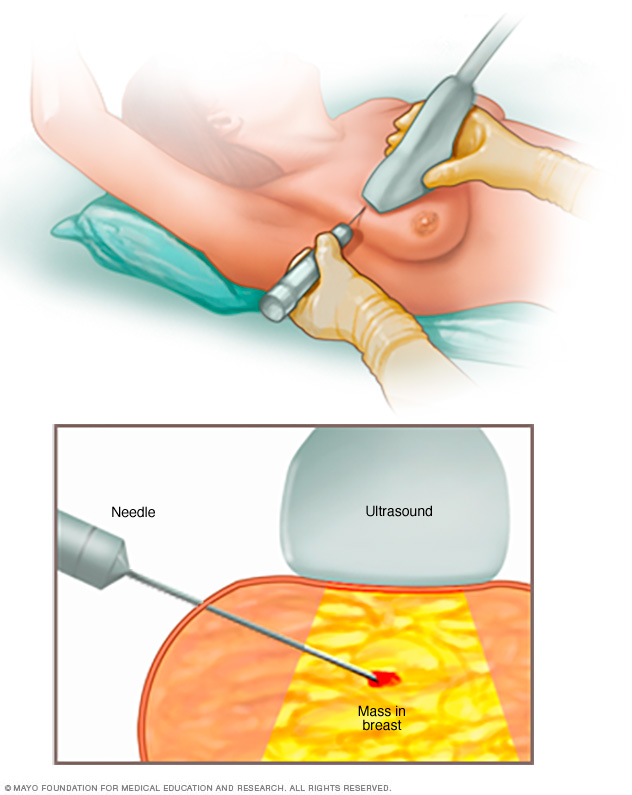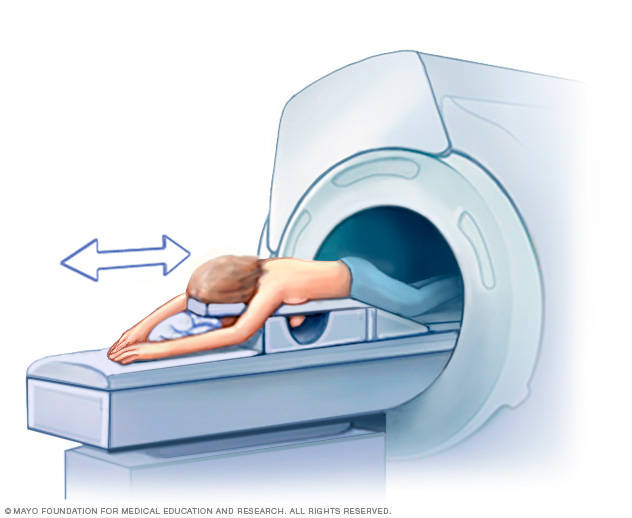Breast biopsy
![]() November, 20th, 2024
November, 20th, 2024
Summary
Learn about this test that’s used to diagnose breast cancer, including why it’s done, risks and what to expect.
Overview
, Overview, ,
A breast biopsy is a procedure to remove a sample of breast tissue for testing. The tissue sample is sent to a lab, where doctors who specialize in analyzing blood and body tissue (pathologists) examine the tissue sample and provide a diagnosis.
A breast biopsy might be recommended if you have a suspicious area in your breast, such as a breast lump or other signs and symptoms of breast cancer. It can also be used to investigate unusual findings on a mammogram, ultrasound or other breast exam.
The results of a breast biopsy can show whether the area in question is breast cancer or if it’s not cancerous. The pathology report from the breast biopsy can help your doctor determine whether you need additional surgery or other treatment.

A core needle biopsy uses a long, hollow tube to obtain a sample of tissue. Here, a biopsy of a suspicious breast lump is being done. The sample is sent to a lab for testing by doctors called pathologists. They specialize in examining blood and body tissue.
Core needle biopsy Why it’s done
Your doctor may recommend a breast biopsy if:
- You or your doctor feels a lump or thickening in the breast, and your doctor suspects breast cancer
- Your mammogram shows a suspicious area in your breast
- An ultrasound scan or breast magnetic resonance imaging (MRI) reveals a suspicious finding
- You have unusual nipple or areolar changes, including crusting, scaling, dimpling skin or a bloody discharge
Risks
Risks associated with a breast biopsy include:
- Bruising and swelling of the breast
- Infection or bleeding at the biopsy site
- Altered breast appearance, depending on how much tissue is removed and how the breast heals
- Additional surgery or other treatment, depending on biopsy results
Contact your health care team if you develop a fever, if the biopsy site becomes red or warm, or if you have unusual drainage from the biopsy site. These can be signs of an infection that may require prompt treatment.
How you prepare
Before the breast biopsy, tell your doctor if you:
- Have any allergies
- Have taken aspirin in the last seven days
- Are taking blood-thinning medications
- Are not able to lie on your stomach for an extended period
If the breast biopsy will be done using an MRI, tell your doctor if you have a cardiac pacemaker or other electronic device implanted in your body. Also tell your doctor if you’re pregnant or think you may be pregnant. An MRI generally isn’t recommended in these situations.
What you can expect
Several breast biopsy procedures can be used to obtain a tissue sample from the breast. Your doctor may recommend a particular procedure based on the size, location and other characteristics of the suspicious area in your breast. If it’s not clear why you’re having one type of biopsy instead of another, ask your doctor to explain.
For many biopsies, you’ll get an injection to numb the area of the breast to be biopsied.
Types of breast biopsy procedures include:
-
Fine-needle aspiration biopsy. This is the simplest type of breast biopsy and may be used to evaluate a lump that can be felt during a clinical breast exam. For the procedure, you lie on a table. While steadying the lump with one hand, your doctor uses the other hand to direct a very thin needle into the lump.
The needle is attached to a syringe that can collect a sample of cells or fluid from the lump. Fine-needle aspiration is a quick way to distinguish between a fluid-filled cyst and a solid mass. It may also help avoid a more invasive biopsy procedure. If, however, the mass is solid, you may need a procedure to collect a tissue sample.
-
Core needle biopsy. This type of breast biopsy may be used to assess a breast lump that’s visible on a mammogram or ultrasound or that your doctor feels during a clinical breast exam. A radiologist or surgeon uses a thin, hollow needle to remove tissue samples from the breast mass, most often using ultrasound as a guide.
Several samples, each about the size of a grain of rice, are collected and analyzed. Depending on the location of the mass, other imaging techniques, such as a mammogram or MRI, may be used to guide the positioning of the needle to obtain the tissue sample.
-
Stereotactic biopsy. This type of biopsy uses mammograms to pinpoint the location of suspicious areas within the breast. For this procedure, you generally lie facedown on a padded biopsy table with one of your breasts positioned in a hole in the table. Or you may have the procedure in a seated position. You may need to remain in this position for 30 minutes to 1 hour.
If you’re lying facedown for the procedure, the table will be raised once you’re in a comfortable position. Your breast is firmly compressed between two plates while mammograms are taken to show the radiologist the exact location of the area for biopsy.
The radiologist makes a small incision — about 1/4 inch long (about 6 millimeters) — into the breast. He or she then inserts either a needle or a vacuum-powered probe and removes several samples of tissue.
-
Ultrasound-guided core needle biopsy. This type of core needle biopsy involves ultrasound — an imaging method that uses high-frequency sound waves to produce precise images of structures within the body. During this procedure, you lie on your back or side on an ultrasound table.
Holding the ultrasound device against the breast, the radiologist locates the mass, makes a small incision to insert the needle, and takes several core samples of tissue.
-
MRI-guided core needle biopsy. This type of core needle biopsy is done under guidance of an MRI — an imaging technique that captures multiple cross-sectional images of the breast and combines them, using a computer, to generate detailed 3D pictures. During this procedure, you lie facedown on a padded scanning table. Your breasts fit into a hollow depression in the table.
The MRI machine provides images that help determine the exact location for the biopsy. A small incision about 1/4 inch long (about 6 millimeters) is made to allow the core needle to be inserted. Several samples of tissue are taken.
At the time of the breast biopsy procedures noted above, a tiny stainless steel or titanium marker or clip may be placed in the breast at the biopsy site. This is done so that if the biopsy shows cancer cells or precancerous cells, your doctor or surgeon can locate the biopsy area to remove more breast tissue during an operation (surgical biopsy). These clips cause no pain or disfigurement and don’t interfere when going through metal detectors, such as at an airport.
-
Surgical biopsy. During a surgical biopsy, some or all of the breast mass is removed for examination. A surgical biopsy is usually done in an operating room using sedation given through a vein in the hand or arm and a local anesthetic to numb the breast.
If the breast mass can’t be felt, the radiologist may use a technique called wire or seed localization to map the route to the mass for the surgeon. This is done before surgery.
During wire localization, the tip of a thin wire is positioned within the breast mass or just through it.
If seed localization is done, a small radioactive seed will be placed using a thin needle. The seed will guide the surgeon to the area where the cancer is located. The seed is safe and gives off only a very small amount of radiation.
During surgery, the surgeon will attempt to remove the entire breast mass along with the wire or seed. To help ensure that the entire mass has been removed, the tissue is sent to the hospital lab for evaluation. Pathologists working in the lab will work to confirm whether breast cancer is present in the mass. They also evaluate the edges (margins) of the mass to determine whether cancer cells are present in the margins (positive margins).
If cancer cells are present at the margins, you may need another surgery so that more tissue can be removed. If the margins are clear (negative margins), then the cancer has been removed adequately.
After a breast biopsy
With all types of breast biopsy except a surgical biopsy, you’ll go home with only bandages and an ice pack over the biopsy site. Although you should take it easy for the rest of the day, you’ll be able to resume your usual activities within a day.
Bruising is common after core needle biopsy procedures. To ease pain and discomfort after a breast biopsy, you may take a nonaspirin pain reliever containing acetaminophen (Tylenol, others) and apply a cold pack as needed to reduce swelling.
If you have a surgical biopsy, you’ll likely have stitches. You’ll likely go home the same day of the procedure, and you can typically resume your usual activities the next day. Your health care team will tell you how to protect your stitches.

During a stereotactic breast biopsy, the breast is firmly compressed between two plates. Breast X-rays, called mammograms, are used to produce stereo images. Stereo images are images of the same area from different angles. They help to determine the exact location for the biopsy. A sample of breast tissue in the area of concern is then removed with a needle.

Getting a breast MRI involves lying face down on a padded scanning table. The breasts fit into a hollow space in the table. The hollow has coils that get signals from the MRI. The table slides into the large opening of the MRI machine.
Breast MRI Results
It may be several days before the results of a breast biopsy are available. After the biopsy procedure, the breast tissue is sent to a lab, where a doctor who specializes in analyzing blood and body tissue (pathologist) examines the sample using a microscope and special procedures.
The pathologist prepares a pathology report that is sent to your doctor, who will share the results with you. The pathology report includes details about the size and consistency of the tissue samples and the location of the biopsy site. The report describes whether cancer, noncancerous changes or precancerous cells were present.
If the pathology report states that only healthy tissue or benign breast changes were detected, your doctor will need to see if the radiologist and pathologist agree on the findings. Sometimes the opinions of these two experts differ. For instance, the radiologist may find that your mammogram results suggest a more suspicious lesion such as breast cancer or a precancerous lesion, but your pathology report reveals only healthy breast tissue. In this situation, you may need more surgery to obtain more tissue to further evaluate the area.
If the pathology report says that breast cancer is present, it will include information about the cancer itself, such as what type of breast cancer you have and additional information, such as whether the cancer is hormone receptor positive or negative. You and your doctor can then develop a treatment plan that best suits your needs.
© 1998-2025 Mayo Foundation for Medical Education and Research (MFMER). All rights reserved. Terms of Use



